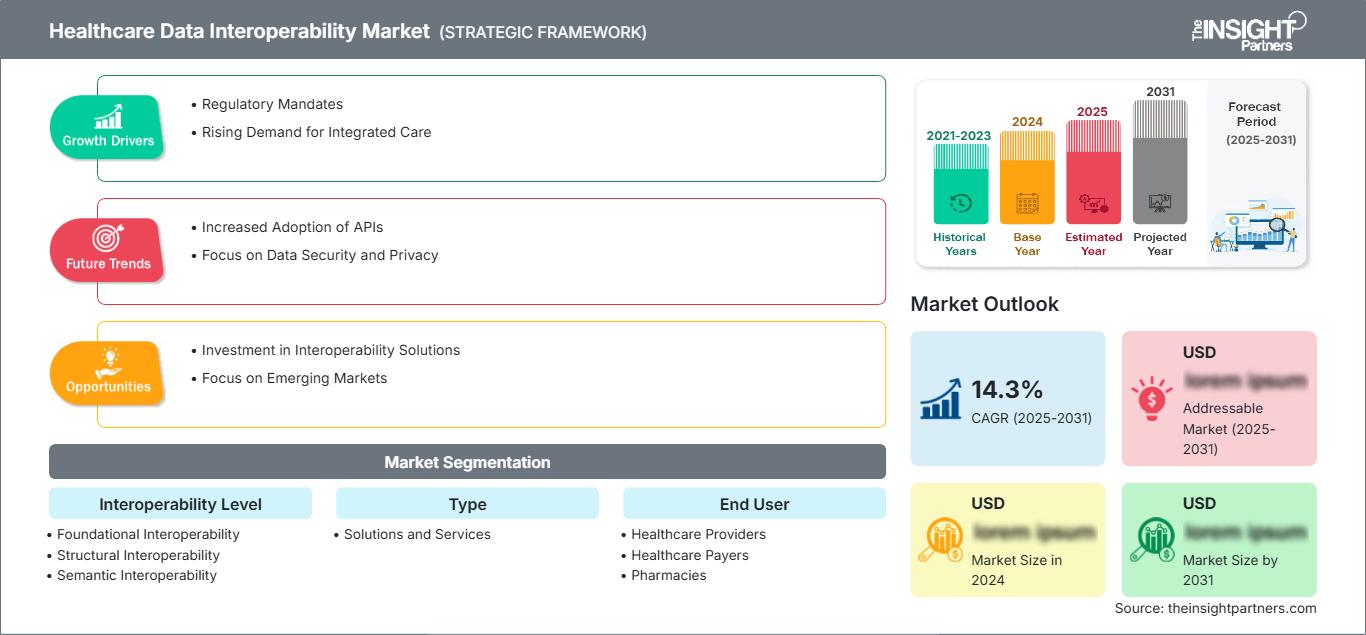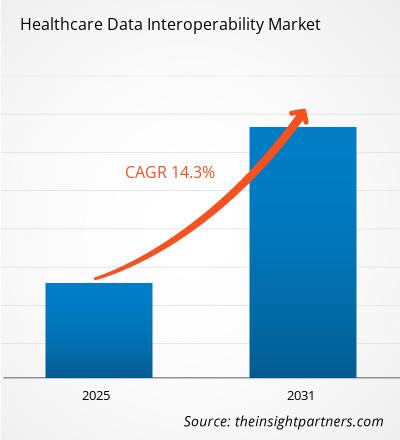ヘルスケアデータ相互運用性市場は、2025年から2031年にかけて年平均成長率(CAGR)14.3%で成長し、市場規模は2024年のXX百万米ドルから2031年にはXX百万米ドルに拡大すると予想されています。
レポートは、相互運用性レベル(基礎的相互運用性、構造的相互運用性、セマンティック相互運用性)、タイプ(ソリューションとサービス)、エンドユーザー(医療提供者、医療保険者、薬局)別にセグメント化されています。グローバル分析は、地域レベルと主要国別にさらに細分化されています。レポートでは、上記の分析とセグメントの米ドル建ての値を示しています。
レポートの目的
The Insight Partnersによるヘルスケアデータ相互運用性市場レポートは、現在の状況と将来の成長、主な推進要因、課題、および機会を説明することを目的としています。これにより、次のようなさまざまなビジネス関係者に洞察が提供されます。
- テクノロジープロバイダー/メーカー: 進化する市場のダイナミクスを理解し、潜在的な成長機会を把握して、情報に基づいた戦略的決定を下せるようにします。
- 投資家: 市場の成長率、市場の財務予測、バリューチェーン全体に存在する機会に関する包括的なトレンド分析を実施します。
- 規制機関: 乱用を最小限に抑え、投資家の信頼と信用を維持し、市場の完全性と安定性を維持することを目的として、市場におけるポリシーと警察活動を規制します。
医療データの相互運用性市場セグメンテーション相互運用性レベル
- 基礎的な相互運用性
- 構造的な相互運用性
- セマンティックな相互運用性
タイプ
- ソリューションとサービス
エンドユーザー
- 医療提供者
- 医療保険者
- 薬局
地域
- 北米
- ヨーロッパ
- アジア太平洋地域
- 中東およびアフリカ
- 南米および中米
レポートの一部、国レベルの分析、Excelデータパックなどを含め、スタートアップ&大学向けに特別オファーや割引もご利用いただけます(無償)
ヘルスケアデータ相互運用性市場: 戦略的洞察

-
このレポートの主要な市場動向を入手してください。この無料サンプルには、市場動向から見積もりや予測に至るまでのデータ分析が含まれます。
医療データ相互運用性市場の成長促進要因
- 規制義務:政府や規制機関は、医療システムにおける相互運用性の必要性にますます注目しています。米国の21世紀治療法法などの取り組みでは、医療機関が患者の医療情報へのアクセスを改善し、ケアの調整を強化するために、相互運用可能なシステムを採用することが義務付けられています。
- 統合ケアの需要の高まり:医療が価値に基づくケアモデルへと移行するにつれ、医療提供者間でシームレスなデータ共有を実現する統合ケアソリューションの必要性が高まっています。相互運用性は、医療専門家間のコミュニケーションとコラボレーションを改善し、患者の転帰の改善につながります。
医療データ相互運用性市場の将来の動向
- APIの採用増加:今後、APIの使用が増加すると見込まれます。これにより、医療分野のアプリケーションは、より効率的に情報を通信および共有できるようになります。 API の使用により、異なるプラットフォーム間の相互運用性を向上させる、より革新的なソリューションが可能になります。
- データセキュリティとプライバシーへの重点:データ共有は、データセキュリティと患者の機密性への重点が高まるにつれて増加します。相互運用性ソリューションには、機密性の高い医療情報を保護するために、暗号化やアクセス制御などの強化されたセキュリティ機能が組み込まれます。
医療データ相互運用性の市場機会
- 相互運用性ソリューションへの投資:医療機関は、業務の効率化と患者のケアの質向上のため、相互運用性ソリューションへの投資を増やしています。革新的で拡張性の高い相互運用性ソリューションを持つ企業が、これを最大限活用できます。
- 新興市場への重点:新興市場の医療システムが進化するにつれ、特定のニーズに合わせた相互運用性ソリューションを導入する機会が生まれます。
ヘルスケアデータの相互運用性市場に関する地域別洞察
The Insight Partnersのアナリストは、予測期間を通じてヘルスケアデータ相互運用性市場に影響を与える地域的な傾向と要因を詳細に解説しています。このセクションでは、北米、ヨーロッパ、アジア太平洋、中東・アフリカ、中南米におけるヘルスケアデータ相互運用性市場のセグメントと地域についても解説しています。
ヘルスケアデータ相互運用性市場レポートの範囲
| レポート属性 | 詳細 |
|---|---|
| の市場規模 2024 | US$ XX million |
| 市場規模別 2031 | US$ XX Million |
| 世界的なCAGR (2025 - 2031) | 14.3% |
| 過去データ | 2021-2023 |
| 予測期間 | 2025-2031 |
| 対象セグメント |
By 相互運用性レベル
|
| 対象地域と国 |
北米
|
| 市場リーダーと主要企業の概要 |
|
ヘルスケアデータの相互運用性市場におけるプレーヤーの密度:ビジネスダイナミクスへの影響を理解する
ヘルスケアデータ相互運用性市場は、消費者の嗜好の変化、技術の進歩、製品メリットへの認知度の向上といった要因によるエンドユーザーの需要増加に牽引され、急速に成長しています。需要が高まるにつれ、企業は提供内容を拡大し、消費者ニーズを満たすためのイノベーションを推進し、新たなトレンドを捉えることで、市場の成長をさらに加速させています。

- 入手 ヘルスケアデータ相互運用性市場 主要プレーヤーの概要
主なセールスポイント
- 包括的な調査範囲:本レポートは、ヘルスケアデータ相互運用性市場における製品、サービス、タイプ、エンドユーザーの分析を包括的に網羅し、包括的な展望を提供しています。
- 専門家による分析:本レポートは、業界の専門家とアナリストの深い理解に基づいて作成されています。
- 最新情報:本レポートは、最新の情報とデータトレンドを網羅しているため、ビジネスの関連性を保証します。
- カスタマイズオプション:本レポートは、特定のクライアントの要件に対応し、ビジネス戦略に適切に適合するようにカスタマイズできます。
したがって、ヘルスケアデータ相互運用性市場に関する調査レポートは、業界のシナリオと成長見通しを解読し理解するための先導役となります。いくつかの正当な懸念事項があるかもしれませんが、本レポートの全体的なメリットは、デメリットを上回る傾向があります。
- 過去2年間の分析、基準年、CAGRによる予測(7年間)
- PEST分析とSWOT分析
- 市場規模価値/数量 - 世界、地域、国
- 業界と競争環境
- Excel データセット
最新レポート
関連レポート
お客様の声
購入理由
- 情報に基づいた意思決定
- 市場動向の理解
- 競合分析
- 顧客インサイト
- 市場予測
- リスク軽減
- 戦略計画
- 投資の正当性
- 新興市場の特定
- マーケティング戦略の強化
- 業務効率の向上
- 規制動向への対応






















 無料サンプルを入手 - ヘルスケアデータ相互運用性市場
無料サンプルを入手 - ヘルスケアデータ相互運用性市場